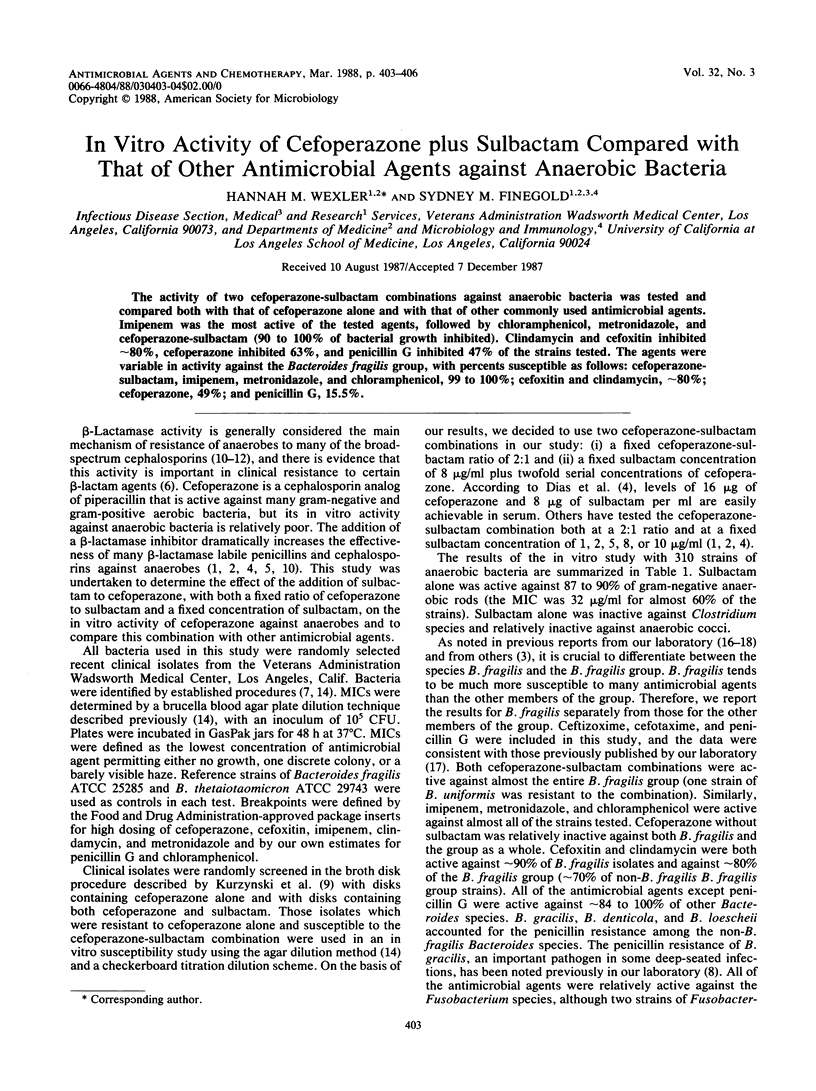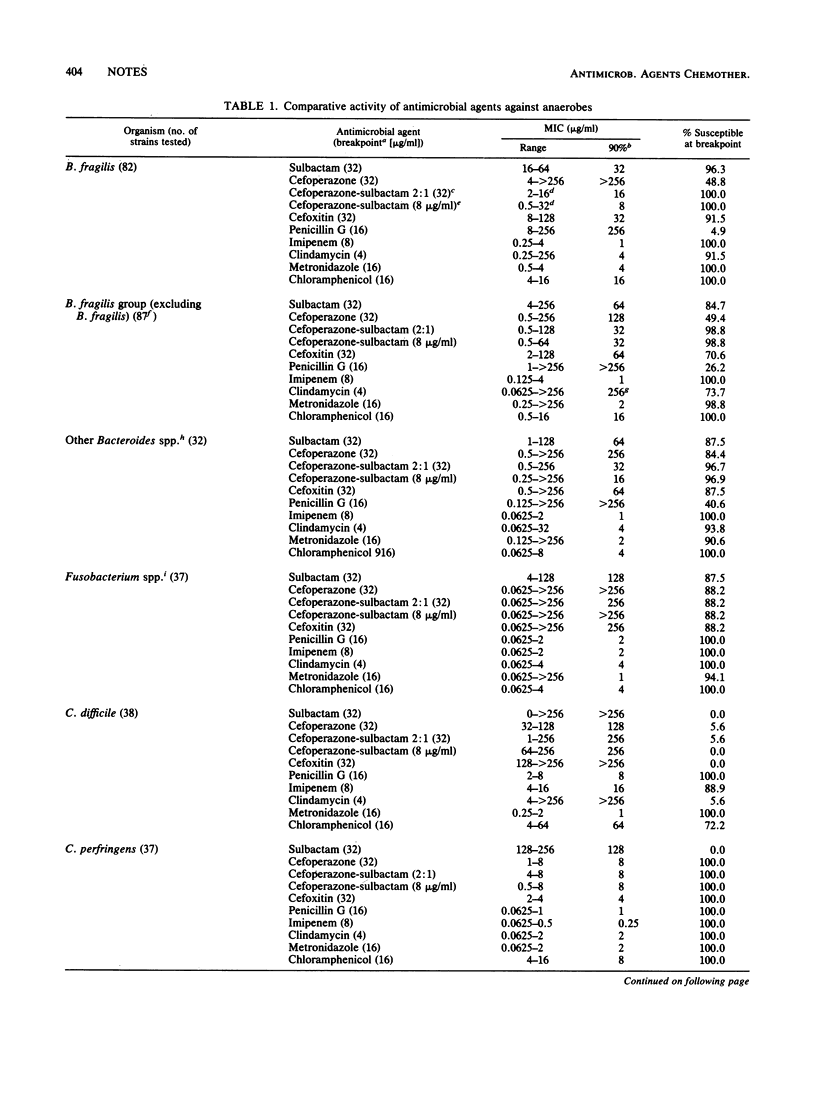Abstract
The activity of two cefoperazone-sulbactam combinations against anaerobic bacteria was tested and compared both with that of cefoperazone alone and with that of other commonly used antimicrobial agents. Imipenem was the most active of the tested agents, followed by chloramphenicol, metronidazole, and cefoperazone-sulbactam (90 to 100% of bacterial growth inhibited). Clindamycin and cefoxitin inhibited approximately 80%, cefoperazone inhibited 63%, and penicillin G inhibited 47% of the strains tested. The agents were variable in activity against the Bacteroides fragilis group, with percents susceptible as follows: cefoperazone-sulbactam, imipenem, metronidazole, and chloramphenicol, 99 to 100%; cefoxitin and clindamycin, approximately 80%; cefoperazone, 49%; and penicillin G, 15.5%.
Full text
PDF



Selected References
These references are in PubMed. This may not be the complete list of references from this article.
- Appelbaum P. C., Jacobs M. R., Spangler S. K., Yamabe S. Comparative activity of beta-lactamase inhibitors YTR 830, clavulanate, and sulbactam combined with beta-lactams against beta-lactamase-producing anaerobes. Antimicrob Agents Chemother. 1986 Nov;30(5):789–791. doi: 10.1128/aac.30.5.789. [DOI] [PMC free article] [PubMed] [Google Scholar]
- Crosby M. A., Gump D. W. Activity of cefoperazone and two beta-lactamase inhibitors, sulbactam and clavulanic acid, against Bacteroides spp. correlated with beta-lactamase production. Antimicrob Agents Chemother. 1982 Sep;22(3):398–405. doi: 10.1128/aac.22.3.398. [DOI] [PMC free article] [PubMed] [Google Scholar]
- Cuchural G. J., Jr, Tally F. P., Jacobus N. V., Gorbach S. L., Aldridge K., Cleary T., Finegold S. M., Hill G., Iannini P., O'Keefe J. P. Antimicrobial susceptibilities of 1,292 isolates of the Bacteroides fragilis group in the United States: comparison of 1981 with 1982. Antimicrob Agents Chemother. 1984 Aug;26(2):145–148. doi: 10.1128/aac.26.2.145. [DOI] [PMC free article] [PubMed] [Google Scholar]
- Fu K. P., Neu H. C. Synergistic activity of cefoperazone in combination with beta-lactamase inhibitors. J Antimicrob Chemother. 1981 Mar;7(3):287–292. doi: 10.1093/jac/7.3.287. [DOI] [PubMed] [Google Scholar]
- Heimdahl A., von Konow L., Nord C. E. Isolation of beta-lactamase-producing Bacteroides strains associated with clinical failures with penicillin treatment of human orofacial infections. Arch Oral Biol. 1980;25(10):689–692. doi: 10.1016/0003-9969(80)90102-8. [DOI] [PubMed] [Google Scholar]
- Johnson C. C., Reinhardt J. F., Edelstein M. A., Mulligan M. E., George W. L., Finegold S. M. Bacteroides gracilis, an important anaerobic bacterial pathogen. J Clin Microbiol. 1985 Nov;22(5):799–802. doi: 10.1128/jcm.22.5.799-802.1985. [DOI] [PMC free article] [PubMed] [Google Scholar]
- Kurzynski T. A., Yrios J. W., Helstad A. G., Field C. R. Aerobically incubated thioglycolate broth disk method for antibiotic susceptibility testing of anaerobes. Antimicrob Agents Chemother. 1976 Oct;10(4):727–732. doi: 10.1128/aac.10.4.727. [DOI] [PMC free article] [PubMed] [Google Scholar]
- Lamothe F., Auger F., Lacroix J. M. Effect of clavulanic acid on the activities of ten beta-lactam agents against members of the Bacteroides fragilis group. Antimicrob Agents Chemother. 1984 May;25(5):662–665. doi: 10.1128/aac.25.5.662. [DOI] [PMC free article] [PubMed] [Google Scholar]
- Nord C. E., Olsson-Liljequist B. Anaerobic bacteria and beta-lactam antibiotics. Scand J Infect Dis Suppl. 1984;42:72–82. [PubMed] [Google Scholar]
- Olsson-Liljequist B., Nord C. E. In vitro susceptibility of anaerobic bacteria to nitroimidazoles. Scand J Infect Dis Suppl. 1981;26:42–45. [PubMed] [Google Scholar]
- Olsson B., Dornbusch K., Nord C. E. Factors contributing to resistance to beta-lactam antibiotics in Bacteroides fragilis. Antimicrob Agents Chemother. 1979 Feb;15(2):263–268. doi: 10.1128/aac.15.2.263. [DOI] [PMC free article] [PubMed] [Google Scholar]
- Souza Dias M. B., Jacobus N. V., Tally F. P. In-vitro activity of cefoperazone-sulbactam against Bacteroides species. J Antimicrob Chemother. 1986 Oct;18(4):467–471. doi: 10.1093/jac/18.4.467. [DOI] [PubMed] [Google Scholar]
- Watt B., Jack E. P. What are anaerobic cocci? J Med Microbiol. 1977 Nov;10(4):461–468. doi: 10.1099/00222615-10-4-461. [DOI] [PubMed] [Google Scholar]
- Wexler H. M., Finegold S. M. Antimicrobial resistance in Bacteroides. J Antimicrob Chemother. 1987 Feb;19(2):143–146. doi: 10.1093/jac/19.2.143. [DOI] [PubMed] [Google Scholar]
- Wexler H. M., Harris B., Carter W. T., Finegold S. M. In vitro efficacy of sulbactam combined with ampicillin against anaerobic bacteria. Antimicrob Agents Chemother. 1985 May;27(5):876–878. doi: 10.1128/aac.27.5.876. [DOI] [PMC free article] [PubMed] [Google Scholar]
- Wexler H., Carter W. T., Harris B. H., Finegold S. M. In vitro activity of cefbuperazone against anaerobic bacteria. Antimicrob Agents Chemother. 1985 Apr;27(4):674–676. doi: 10.1128/aac.27.4.674. [DOI] [PMC free article] [PubMed] [Google Scholar]


